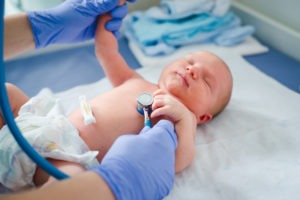
What causes apraxia in infants varies, although it may occur as a result of a preventable birth injury in some cases. Babies who suffer a stroke, traumatic brain injury, brain ischemia, or hemorrhage before, during, or soon after birth may have apraxia from the time their injury occurs. Some genetic disorders can cause congenital apraxia. Because it takes months or even years to diagnose a child with apraxia, the cause may not be clear.
Apraxia, formally known as childhood apraxia of speech (CAS), is a speech disorder that prevents children from developing language properly and communicating clearly. Their brain cannot coordinate the movements necessary to form sounds and words properly.
Understanding Childhood Apraxia of Speech
What causes apraxia in infants is not a problem with weak muscles or muscle control. Instead, it is an issue within the brain. Older children with speech apraxia know what they are trying to say and what they want to communicate. The problem lies within the pathways in their brains that signal the complex coordination of movements required to speak. The brain cannot properly tell the mouth, lips, tongue, and voice how to work together to pronounce some or all the sounds.
This disorder affects children in dramatically different ways. Some children struggle with only a few sounds or sounds that require only a specific movement. Others only speak a few words, while some cannot clearly communicate at all.
"If your child was born with a birth injury, or cerebral palsy, we can help."
Signs and Symptoms of Apraxia in Babies and Toddlers
In many cases, a child does not receive an apraxia diagnosis until age three or later. In cases when the child’s ability to communicate is not significantly affected, the diagnosis could be delayed even further. Symptoms may become apparent when their teachers in preschool or kindergarten note that they struggle with certain sounds or pronounce things differently than their peers.
Some of the earliest signs of speech apraxia include:
- Struggles with latching to feed or eating from a spoon
- Very quiet babies who do not babble or make other noises
- Late language development, including missing milestones related to first words
- Makes very few limited vocal noises, such as specific vowels
As children get older, you may notice other symptoms, such as:
- Struggling to copy what you say or make similar noises
- Choppy or monotonous speech
- Accenting the wrong syllable
- Incorrect pronunciation of words or specific sounds
- Using noises and pointing to communicate instead of words
In some cases, these children also have other related concerns. They may struggle with fine motor skills, handwriting, reading, spelling, and other issues. These issues may pose another hurdle when working with these children on alternative options for communication, such as writing or using communication tools and devices.
Speech and occupational therapy may help. Children with childhood apraxia of speech generally work closely with a speech-language pathologist. Depending on the severity of their apraxia, this may occur as a part of early intervention and could occur three to five times a week to start. Your child may require speech therapy and support for several years, but many develop much more understandable speech through therapy.
Building a Birth Injury Case Based on an Apraxia Diagnosis
To recover compensation based on your child’s speech apraxia diagnosis, you will need to prove the link between the negligence of the doctor or another care provider and your child’s birth injury. Luckily, you do not have to prove this link on your own. Your lawyer will know what is required to prove medical malpractice in a birth injury case in your state. Generally, this includes:
- A review of the relevant medical records and documents
- A medical expert witness reviewing these records
- The expert witness agreeing that malpractice occurred
Your attorney can also help you understand the applicable state deadlines in your case, which could stem from:
- The state’s statute of limitations on medical malpractice cases
- The state’s rules for tolling the statute of limitations on infant victims
- The state’s statute of repose that applies in your case
The damages available if your attorney secures a payout in your case through an insurance claim or lawsuit could include:
- Diagnosis, treatment, therapy, and support costs
- Prescribed equipment and communication devices
- Time parents missed at work because of the child’s therapy and treatment
- Related out-of-pocket expenses
- Pain and suffering
- Other non-economic losses
"We know first-hand what you are going through."
Get Help Today with Your Child’s Birth Injury Malpractice Case
You can get help today with your child’s birth injury medical malpractice case by calling the Birth Injury Lawyers Group. We are ready to review your case for free. We want to discuss your child’s diagnosis, how it affects your life, their prognosis, and the treatment they are receiving and will likely receive.
You can speak with a member of our team now by calling (800) 222-9529. We know how birth injury cases work in your state and how to determine if medical negligence was likely in your child’s birth injury.
"We are committed to helping families who have suffered medical negligence."
